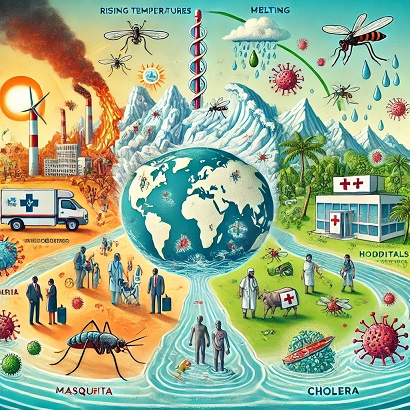The Impact of Climate Change on the Spread and Intensification of Infectious Diseases
How is The Impact of Climate Change on the Infectious Diseases?

Introduction
Climate change is recognized as one of the critical and significant issues of today, with extensive effects on human life and the environment. These climatic changes not only lead to environmental destruction, loss of biodiversity, and degradation of natural resources but also have serious implications for public health. One significant aspect of climate change's impact on public health is its influence on the spread and intensification of infectious diseases. This article explores these effects and the relationship between climate change and the increase in infectious diseases.

Section 1: Effects of Climate Change on Health
Climate change results in alterations in weather patterns, precipitation, temperature, and seasonal variations, which can have broad direct and indirect impacts on human health. Rising temperatures increase the risk of heat-related incidents, respiratory issues, cardiovascular diseases, and reduced air quality. Changes in precipitation patterns can lead to an increased risk of floods, droughts, and water contamination, which may contribute to the spread of climate-related diseases, increase inflammatory sensitivities and allergies, and exacerbate conditions such as asthma and cardiovascular diseases. Therefore, climate change directly affects public health, necessitating effective prevention and management measures to mitigate these impacts.
Section 2: Impact of Climate Change on the Spread of Infectious Diseases
Climate change can have both direct and indirect effects on the spread of infectious diseases. Increased temperature and humidity can create favorable conditions for the growth and transmission of microorganisms such as viruses and bacteria. Additionally, changes in precipitation patterns and increased water availability can lead to outbreaks of waterborne diseases, such as microbial aquatic infections, malaria, and gastrointestinal diseases. Changes in precipitation patterns may also facilitate the spread of vector-borne diseases, such as Zika virus and dengue fever, as well as transmission of diseases like dysentery and cholera. Thus, climate change can directly contribute to the increased prevalence of infectious diseases, necessitating effective prevention, control, and management measures.
Section 3: Strategies and Measures to Address the Impact of Climate Change on Infectious Diseases
To address the impacts of climate change on the spread of infectious diseases, measures such as developing early warning systems, strengthening public health and environmental health systems, increasing public education and awareness about disease prevention, and implementing disease management and prevention programs are essential. Additionally, utilizing advanced technologies such as disease prevention systems based on meteorological data and communication networks, and enhancing health and treatment infrastructure in vulnerable areas are also effective measures.
Addressing the impact of climate change on infectious disease spread requires serious and coordinated actions from international and national communities. One effective strategy is the development of early warning systems and prevention programs. These systems can help in the early detection of new diseases and prevent their outbreaks. Furthermore, strengthening public health and environmental health systems is crucial. This includes improving air and water quality, controlling air and water pollution, and enhancing sanitary conditions in vulnerable areas. Increasing public awareness about preventive measures for infectious diseases and the importance of addressing climate change is also fundamental. In addition, the development of advanced technologies such as disease prevention systems based on meteorological data and communication networks can aid in managing diseases under climate change conditions. These combined efforts can help reduce the spread of infectious diseases in the face of climate change and improve public health outcomes.
Conclusion
Climate change is recognized as one of the major challenges of future centuries, with widespread effects on human health. To mitigate the negative impacts of these changes on the spread of infectious diseases, coordinated and serious actions from both international and national communities are required. By implementing these measures, we can ensure improvements in public health and support sustainable and resilient development in the face of climate change.




comment